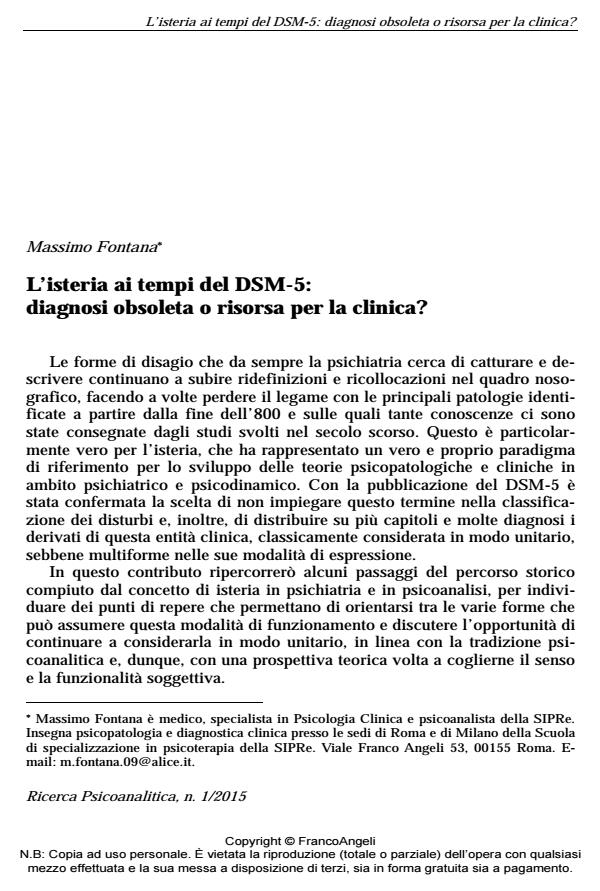L’isteria ai tempi del DSM-5: diagnosi obsoleta o risorsa per la clinica?
Titolo Rivista RICERCA PSICOANALITICA
Autori/Curatori Massimo Fontana
Anno di pubblicazione 2015 Fascicolo 2015/1
Lingua Italiano Numero pagine 16 P. 85-100 Dimensione file 69 KB
DOI 10.3280/RPR2015-001007
Il DOI è il codice a barre della proprietà intellettuale: per saperne di più
clicca qui
Qui sotto puoi vedere in anteprima la prima pagina di questo articolo.
Se questo articolo ti interessa, lo puoi acquistare (e scaricare in formato pdf) seguendo le facili indicazioni per acquistare il download credit. Acquista Download Credits per scaricare questo Articolo in formato PDF

FrancoAngeli è membro della Publishers International Linking Association, Inc (PILA)associazione indipendente e non profit per facilitare (attraverso i servizi tecnologici implementati da CrossRef.org) l’accesso degli studiosi ai contenuti digitali nelle pubblicazioni professionali e scientifiche
L’A. ripercorre i passaggi principali del percorso storico compiuto dalla diagnosi d’isteria in psicoanalisi e in psichiatria, descrivendone le vicissitudini nel Manuale Diagnostico e Statistico del Disturbi Mentali, dal DSM-II (1968) al DSM-5 (2013). Nelle ultime edizioni (DSM-IV e DSM-5) il termine "isteria" è stato abbandonato e, con esso, anche la concezione unitaria di questa patologia, presente invece nella tradizione psichiatrica e psicoanalitica a partire dalle prime teorie moderne formulate dalla fine dell’800 (Briquet, Babinski, Bernheim, Charcot, Janet e Freud). I derivati nosologici attuali, nel DSM, possono essere rintracciati in alcune categorie distinte, come il Disturbo di conversione, la Pseudociesi e i Disturbi dissociativi, oltre al Disturbo Istrionico di Personalità. Facendo riferimento ai contributi della psicoanalisi, l’A. individua nella tendenza a comunicare il disagio attraverso canali indiretti (corpo, stati di coscienza, emotività) il denominatore comune del funzionamento isterico, che giustifica il mantenimento di questa diagnosi come categoria concettualmente unitaria.
Parole chiave:Isteria, DSM-5, somatizzazione, conversione
Massimo Fontana, L’isteria ai tempi del DSM-5: diagnosi obsoleta o risorsa per la clinica? in "RICERCA PSICOANALITICA" 1/2015, pp 85-100, DOI: 10.3280/RPR2015-001007